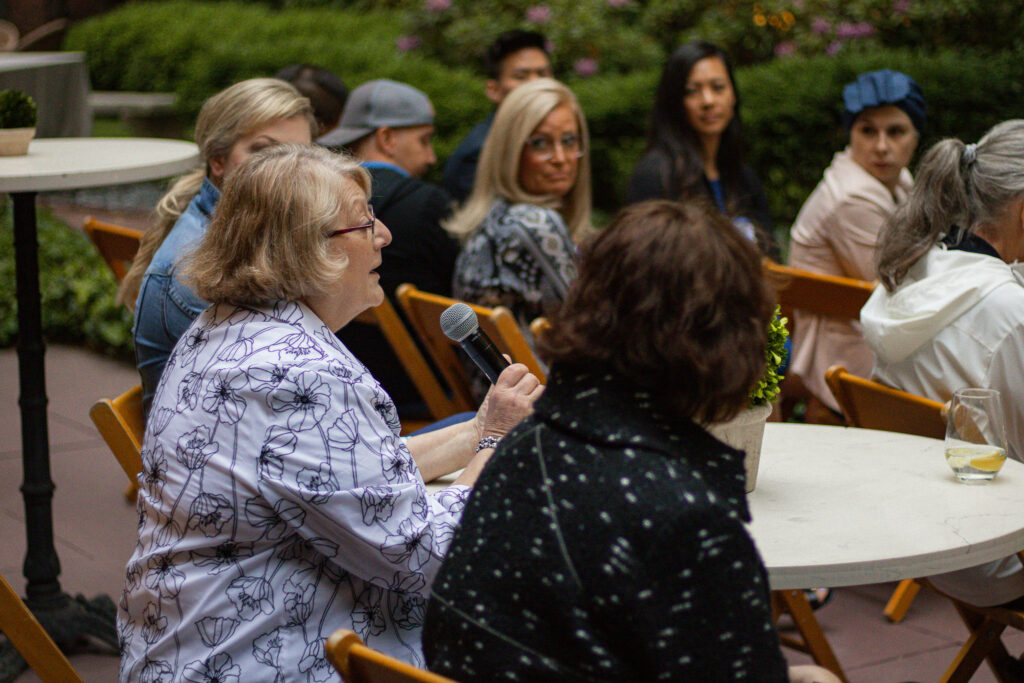Our Chicago area lung cancer community gathered on Tuesday, June 6 to discuss updates to discuss lung cancer updates coming out of the American Society of Clinical Oncology (ASCO) Annual Meeting. Panelists shared their thoughts on the meeting and took general questions from the audience.
Ivy Elkins from EGFR Resisters moderated the panel, which included:
- Nisha Mohindra, MD, 2019 LCRF grantee, Associate Professor, Medicine, Hematology Oncology Division, Feinberg School of Medicine
- Jessica Donington, MD, MSCR, LCRF Scientific Advisory Board member, Professor and Chief General Thoracic Surgery, University of Chicago School of Medicine
- Laila A. Gharzai, MD, Radiation Oncologist, Robert H. Lurie Comprehensive Cancer Center, Northwestern Medicine
- Melanie M. Smith, MD, Palliative Care Physician, Robert H. Lurie Comprehensive Cancer Center, Northwestern Medicine
Palliative care and hospice care
Dr. Smith addressed differences between palliative care and hospice care – a question she noted comes up often in her practice. “When I explain palliative care to patients, to families, even to students or residents, I talk about the three things that we do: symptom management, support for patients and families, and thinking about the future; making sure that your care plan really honors your goals and your values,” she said.
“I would say palliative care is the big umbrella term, and hospice is a little sliver of palliative care,” she explained. “Hospice is really only for patients who are done treating their cancer. Whereas with palliative, we can follow you anywhere on your journey. Most of my patients I see in clinic, sometimes in the hospital, but we are trying to help you tolerate your therapies, right, trying to help you live longer and live better.”
ADAURA trial significance
Dr. Mohindra explained some of the terms used in treatment – neoadjuvant, adjuvant, and perioperative. She noted that these terms were heard often during the ASCO meeting. “It’s in relation to the curative intent surgeries, is generally how I think of it,” she said. “Neoadjuvant is treatment that’s delivered prior to surgery. Adjuvant is treatment that’s delivered after surgical resection, and perioperative is where it’s given on both ends of the spectrum. So that’s how the landscape is evolving.”
The ADAURA trial, which Dr. Mohindra noted “was a big headliner for ASCO this year,” looked at the use of osimertinib, an EGFR-directed therapy, after a surgical resection. “Without going through all the details of the trial, it significantly improved survival by using osimertinib compared to not using osimertinib. We knew there were early hints that disease recurrence was much less when you used osimertinib, but we finally saw what we all are waiting for in lung cancer – that there was a true survival benefit.”
“I think that that not only confirms its place in the landscape post-surgery, but now gives data and possibly access to different parts of the world – some patients, depending on where you are located, may not have access to drugs until certain metrics are met.”
Another trial looked at chemotherapy with immunotherapy before surgery and up to a year after. “Anything we’ve seen over the last couple of years shows this approach with the right patients has led to significant improvements in keeping the disease from coming back,” said Dr. Mohindra.
New approaches to surgery
Dr. Donington spoke about the presentation she had given at ASCO on the resection of localized lung cancer. “A lot of the big press at ASCO on resectable lung cancer happened in patients with stage two and three disease, where all of these medicines are making a huge benefit. But in stage one disease, our earliest patients, we’ve also made some significant changes,” she explained “It’s actually kind of unusual in lung cancer – we’re actually learning how to deescalate the surgeries that we do, taking less lung for the same oncologic benefit.”
Two large trials in the past two years compared lobectomy – the surgery most patients undergo – with a sub lobar resection, taking a portion of the lobe instead. This procedure is for select patients, Dr. Donington explained, “not every patient, but patients with tumors less than two centimeters. It actually showed that in well-selected patients, they did better. If we left more lung, that lung’s important – these are organs you need, and the more you leave is better.”
With increased lung cancer screening, the hope is to find nodules that are a centimeter in size, rather than three or four. “In that case, doing a less of an operation is really exciting. It does bring some new technical hurdles. Sometimes some of these little itty bitty lung cancers are hard for us to find and locate and make sure they’re in the right place. But those are good things to take on, because it’s nice to leave your patients with as much lung as possible.”
LCRF continued discussing findings presented at ASCO during its July #TogetherSeparately livestream. Find out more at LCRF.org/together.
Photo credit: Shelby Domabyl-Deiters





